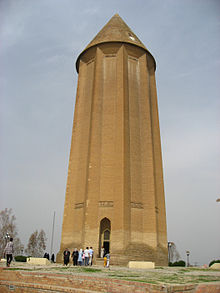Golestan (Province)
| استان گلستان Golestan
|
|
|---|---|
| Location of the Golestan Province in Iran | |
| Basic data | |
| Country | Iran |
| Capital | Gorgan |
| surface | 20,195 km² |
| Residents | 1,868,819 (2016 census) |
| density | 93 inhabitants per km² |
| ISO 3166-2 | IR-27 |
Coordinates: 37 ° 16 ' N , 54 ° 51' E
Golestan ( Persian استان گلستان Ostan-e Golestan , DMG Ostān-e Golestān , Azerbaijani Gülüstan , Kurdish گوڵستان Gulistan ) is a province in northern Iran on the southeast coast of the Caspian Sea . Their capital is Gorgan (گرگان).
1,868,819 people live in the province (2016 census). The province covers 20,195 square kilometers and has a population density of 93 people per square kilometer.
Until 1997 it belonged to Mazandaran Province . In addition to Persians , Azerbaijanis , Kurds and Turkmen are also native to the province.
The biggest cities
(VZ = census)
| rank | city | Inhabitants (VZ 2016) |
|---|---|---|
| 1. | Gorgan | 350,676 |
| 2. | Gonbad-e Qaboos | 151.910 |
| 3. | Bandar-e Torkaman | 53,970 |
| 4th | Aliabad | 52,838 |
| 5. | Azajahr | 43,760 |
| 6th | Kordkuy | 39,881 |
| 7th | Kalaleh | 36,176 |
| 8th. | Aq Qal'eh | 35,116 |
| 9. | Minudash | 30,085 |
| 10. | Galikash | 23,394 |
Source: Iran Statistics Bureau
The city of Gorgan was called Esteraba or Astarabad until 1937.
Administrative division
The province of Golestan is divided into 14 administrative districts (Schahrestan).
Products
Cotton , caviar , rice and cereals
Golestan National Park and Hyrcanic Forest
The Golestan National Park is of ecological importance for Iran . It is the oldest Iranian national park, which formerly consisted of two separate protected areas (1957). In 1976 the protected areas Almeh and Yashki were combined to form the national park of today's size (91,890 ha). The Asian Highway runs through the park , which led to considerations about the restructuring of the road network in the national park, which have not yet been implemented. Cutting through the park leads to the disruption of the ecological balance. In addition to a rich flora, the national park is home to over 150 different species of birds, including the rare bearded vulture . The mammals found in Golestan National Park include brown bears , leopards , jackals and various ungulates ( wild boars , deer , gazelles ). An extremely rare subspecies of the cheetah can be found here in very small populations, while the subspecies of the tiger ( Caspian tiger ), formerly native to the province of Golestan, has become extinct here (as worldwide). The Golestan National Park is not only of ecological but also of touristic and cultural importance. On July 5, 2019, it was included in the UNESCO World Heritage List together with 14 other forest areas in the provinces of Golestan, Mazandaran and Gilan under the name " Hyrkanian Forests " .
See also
Web links
Individual evidence
- ↑ a b c Mehrzad Boroujerdi, Mirjam Künkler: Iran Data Portal: Census 2016: Population and Households, by Provinces and Cities. Data portal of the Social Science Research Council ( Princeton University ) and Syracuse University , accessed on July 7, 2019 .
- ↑ Iranian Tourism & Touring Online (ITTO)
- ^ Hyrcanian Forests: Multiple locations (15). UNESCO website, accessed June 7, 2019 .



